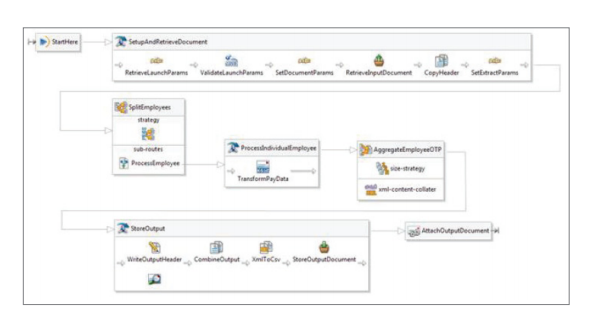What Is Workday Studio?
Workday Studio is a powerful development tool enabling customers and partners to build sophisticated integrations to and from Workday. These integrations are
deployed and run on your behalf on integration servers in Workday’s data center.
Aimed at skilled developers and offered as a set of plug-ins to the Eclipse IDE, Workday Studio offers a rich, graphical development environment in which a user can drag and drop a variety of reusable components that handle the “plumbing” aspects of integration building, freeing you to focus on the critical business logic.
Workday has been using this valuable tool for years to deliver all of our packaged integrations and connectors as well as the EIB.
Use Workday Studio to unlock the power of Workday’s integration infrastructure:• Run your Workday Studio integrations like any other Workday integration—configure, launch, schedule, monitor, and even audit your integrations.
• Use powerful and productive development tools optimized for interacting with your Workday tenant
• Build sophisticated and highly customizable integrations without the need to own or manage any on premise integration middleware or servers.
If the integration you want to develop has any one of the following characteristics, it is a good candidate for a Workday Studio integration:
• Multiple different data sources and/or delivery requirements
• Scalable and efficient processing of potentially very large data sets (up to tens of gigabytes)
• Complex looping or branching logic based on dynamic data or external variables
• Sophisticated change detection requirements
• Complex error scenarios and corresponding need to react differently to error conditions
• Need for rigorous source code control, unit testing, debugging, logging, and other formal development disciplines
• Need to extend with custom capabilities implemented in Java, Spring, or a third-party service
• Need to develop related integrations for other services which also offer an Eclipse-based development environment
Workday Integration Cloud Connect
Workday Integration Cloud Connect consists of a growing number of packaged integrations and connectors to complementary solutions that are 100% built, supported, and maintained by Workday. The benefits of this approach to the customer are many, including access to a set of integrations that are:
• lower cost, lower risk, and faster to deploy without requiring any coding;
• fully supported by Workday and are certified and tested across updates and patches; and
•treated like any other part of the product, with a published product roadmap.
What Is a Packaged Integration?
Workday offers customers complete packaged integration solutions that are built on an open, standards-based API and hosted within the Workday Cloud. This set of integration solutions is delivered, maintained, and supported by Workday and currently includes integration to 160+ benefit carriers, Kronos, TalentLink, Safeguard, Salesforce, Cybersource, and others. Packaged integrations allow customers to leverage their current investments without adding additional costs and overhead within their IT
departments
What Is a Connector?
In addition to packaged integrations, Workday also provides Connectors, which are slightly different from packaged integrations in that they provide a framework for building an integration of a certain type based on integration templates. Examples of Connectors include the Workday Payroll Interface, which reduces the time, cost, and complexity of integrating to third-party payroll providers.
Connectors are configured integrations that generate an intermediate file output format that contains all the needed data and is subsequently transformed to (or
from) a specific vendor format. For example, Workday generates a “Workday” format document, expressed as either XML or CSV, for connecting to a third-party
payroll system that may not be offered as a packaged integration. In this case, you can then simply do the “last mile” yourself (using Workday’s integration tools),
leveraging the packaged Connector, which already represents a large part of the effort.
Other Connectors, such as the ”Payment Connector” and the ”Punchout Connector,” are built to standards that are well structured and consistently adopted by third-party systems. In these cases, customers can configure these Connectors to work with any third-party system (e.g., a bank or supplier) that adheres to the standard.
Integration Cloud Connect consists of the following six sub-networks:
• Cloud Connect for HCM - Extends Workday HCM by integrating to partners that provide capabilities including: recruiting, learning, time and attendance, and account provisioning (LDAP/Active Directory).
• Cloud Connect for Benefits - Extends Workday HCM by providing integration to a growing catalog of benefits providers, including: health insurance, health and flexible spending accounts, retirement savings plans, life insurance, AD&D insurance, and
COBRA administrators
• Cloud Connect for Workday Payroll
• Cloud Connect for Third-Party Payroll
• Cloud Connect for Spend Management
• Cloud Connect for Financials
Putting It All Together: Payments Example
One of the first examples shipped with Workday Studio shows how to create a one-time-payments integration to a third-party payroll vendor. This sample combines a
number of aspects of the integration approach that has been described in this document :
1. Use a packaged connector to define the behavior of
the base one-time-payments integration.
2. Call this integration on a scheduled basis from within a business process.
3. Once the integration completes, forward a reference to the generated document to a second (Workday Studio built) integration, which further processes this output by transforming it into a new file format.
5. Once approvals are complete, deliver the file to the configured third-party endpoint, again powered by the business process framework.
All of the above is fully logged and audited, and any
issues or errors that arise along the way can readily be
corrected and the process re-started.




No comments:
Post a Comment
Note: Only a member of this blog may post a comment.